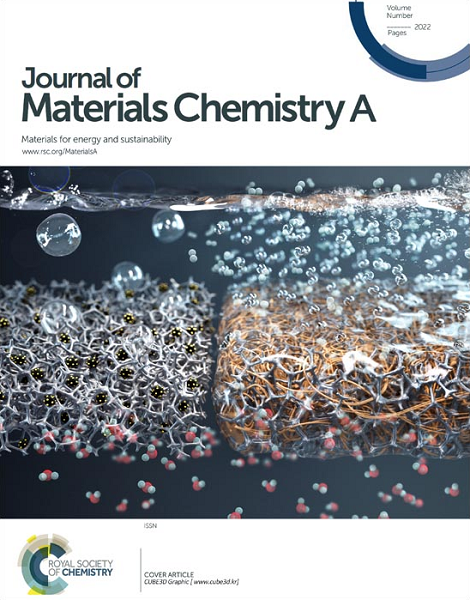Reversible Structural Transformation of Metastable Lead-Free Organic-Inorganic Hybrid Bismuth Halide Single Crystals
IF 10.7
2区 材料科学
Q1 CHEMISTRY, PHYSICAL
引用次数: 0
Abstract
Lead-free organic-inorganic hybrid bismuth halides have been recognized as promising alternatives to lead-based perovskites for non-toxic and environmentally-friendly optoelectronic applications. These materials showcase unique optoelectronic properties, ascribed to their low-dimensional electronic structures, such as a long carrier lifetime, a strong quantum-well effect, self-trapped states, and good stability. However, there is still a lack of understanding of the structure dependency of these properties. Investigations of hybrid bismuth halides are thus highly urgent in the pursuit of developing functional optoelectronic devices utilizing these properties. Herein, we report a new one-dimensional (1D) polymeric organic-inorganic hybrid bismuth halide, PDABiI5 (PDA=1,3-propane diammonium), which forms single crystals of centimeter size with a narrow optical bandgap of 1.77 eV. Interestingly, a reversible moisture-induced dimensional transformation was observed on 1D PDABiI5 through its conversion into 0D dimeric (PDA)2Bi2I10·2H2O, coming with a significant bandgap widening and photoluminescence shifts. This transformation is attributed to water molecules forming hydrogen bonds with the ammonium groups, promoting the deformation of Bi−I bonds from [BiI52-]n chains to edge-sharing [Bi2I10]4- dimers. This phenomenon presents exciting prospects for environmentally responsive device applications. Furthermore, optoelectronic characterizations demonstrated a long carrier lifetime exceeding 2 μs, a defect density of 1.49 x 1010 cm−3 and a high μτ product of 4.06 x 10-4 cm2V−1. This work provides insights into the unique properties of PDABiI5 and (PDA)2Bi2I10·2H2O and their structure-property correlation, and offers promising avenues for the development of eco-friendly and functional optoelectronic devices.可迁移无铅有机无机混合卤化铋单晶的可逆结构转变
无铅有机-无机杂化卤化铋已被公认为是无毒、环保光电应用领域中铅基磷酸盐的理想替代品。这些材料因其低维电子结构而显示出独特的光电特性,如长载流子寿命、强量子阱效应、自阱态和良好的稳定性。然而,人们对这些特性的结构依赖性仍然缺乏了解。因此,在利用这些特性开发功能性光电器件的过程中,对混合卤化铋的研究显得尤为迫切。在此,我们报告了一种新的一维(1D)聚合物有机-无机杂化卤化铋 PDABiI5(PDA=1,3-丙烷二铵),它能形成厘米大小的单晶体,具有 1.77 eV 的窄光带隙。有趣的是,通过将 1D PDABiI5 转化为 0D 二聚体 (PDA)2Bi2I10-2H2O,在 1D PDABiI5 上观察到了湿气诱导的可逆尺寸转化,并伴随着显著的带隙增宽和光致发光偏移。这种转变归因于水分子与铵基团形成氢键,促进了 Bi-I 键从[BiI52-]n 链变形为边缘共享的[Bi2I10]4-二聚体。这一现象为环境响应型器件应用带来了令人振奋的前景。此外,光电特性分析表明其载流子寿命超过 2 μs,缺陷密度为 1.49 x 1010 cm-3,μτ乘积高达 4.06 x 10-4 cm2V-1。这项研究深入揭示了 PDABiI5 和 (PDA)2Bi2I10-2H2O 的独特性质及其结构-性质相关性,为开发环保型功能光电器件提供了前景广阔的途径。
本文章由计算机程序翻译,如有差异,请以英文原文为准。
求助全文
约1分钟内获得全文
求助全文
来源期刊

Journal of Materials Chemistry A
CHEMISTRY, PHYSICAL-ENERGY & FUELS
CiteScore
19.50
自引率
5.00%
发文量
1892
审稿时长
1.5 months
期刊介绍:
The Journal of Materials Chemistry A, B & C covers a wide range of high-quality studies in the field of materials chemistry, with each section focusing on specific applications of the materials studied. Journal of Materials Chemistry A emphasizes applications in energy and sustainability, including topics such as artificial photosynthesis, batteries, and fuel cells. Journal of Materials Chemistry B focuses on applications in biology and medicine, while Journal of Materials Chemistry C covers applications in optical, magnetic, and electronic devices. Example topic areas within the scope of Journal of Materials Chemistry A include catalysis, green/sustainable materials, sensors, and water treatment, among others.
文献相关原料
| 公司名称 | 产品信息 | 采购帮参考价格 |
|---|
 求助内容:
求助内容: 应助结果提醒方式:
应助结果提醒方式:


